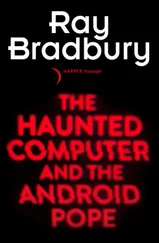But because of the downturn in the house construction trade, Eugene was in a depressed state economically when they moved into town. As a result, these ex-communards from the backwoods, purveyors of transformational software, had all of a sudden become respectable members of the community— employers of twenty-four taxpayers.
I remember one peculiar episode before they became quite so respectable. It was before they had much income from their products and couldn’t afford to go to a trade show in Boston—a place where small software companies stand to make a decent amount of sales. Mary Carol asked us if they could put some of their software on exhibit at our booth. We said “sure” and thought nothing of it. That sense of community was always a big part of the fun of trying to publish software in the early days of the industry, before the shirts and ties and armies of accountants joined the fray. So we agreed, and we put up some new Avant Garde programs in our booth.
My father—a Presbyterian minister, mind you—was manning the Brøderbund booth at that Boston show, blissfully unaware of what was going on around him. Among the Avant Garde packages, it happened, was one of their little social experiments—a very explicit software version of a sex manual. The first thing that happened to Dad was that a nine-year-old Brøderbund enthusiast rushed over to the booth and said “Brøderbund’s my favorite company; what’s that?” pointing, of course, to the sex manual.
“Well, that’s not us, that’s something from Avant Garde,” my dad replied.
“Okay, I’ll take it,” said the kid.
And of course, an hour later a furious father came stomping up with the nine-year-old young man and said to the person at the Brøderbund booth: “He says he bought this from you.” Except, by this time, the person in charge was not my father, but my mother. And she said: “Oh, we’re just selling those for some friends.” Then the father told my mother about the contents of the program, and she was properly mortified.
“We were just doing it for some friends,” she repeated, rather weakly, refunding their money.
“Some fine friends you have,” rejoined the irate father.
When I related the story to Mary Carol, she said, “You know, the world is like that. You try to give out some good information to people and they just can’t take it.” And that fit right into one of Don’s major premises—that people are against you because they won’t accept the perfectly valid information you offer.
Eventually, Avant Garde became profitable enough to attract venture capital. It started taking money from David Silver, a venture capitalist, in 1983. He had to provide progressively more money to keep the company going through the lean times of 1984, which meant that he gained a controlling interest, and eventually he bought out Don and Mary Carol’s share of the company. Don and Mary Carol stayed in Eugene, and in 1985 they started a new software company named Abracadata; once again, they started operating their business from a post office box. Tom Measday, an old friend of David Silver’s (and a former vice president of sales and marketing for Brøderbund), became president of Avant Garde.
In 1984, Avant Garde announced its intention to acquire Human Engineered Software, one of the largest software companies. (We’ll hear more about HES when we look at the shakeout of 1984.) Although the HES acquisition may fall apart in bankruptcy court, in January 1985, Tom Measday announced his intention to buy another dozen software companies within the year. He sent out 200 inquiries to companies, asking if they were interested in being acquired. In February 1985, it looked as if our old neighbors would become our new neighbors, because Measday announced plans to move Avant Garde to San Rafael.
Measday’s decision to relocate Avant Garde may have stemmed from a realization that the company had been too geographically removed from the California action for too many years. Don and Mary Carol never joined in the California social activities during which people from various software companies got to know one another. Perhaps Measday thought it would be beneficial for the company if it played a more prominent role in the California software scene. As for myself, I remember, when Broderbund was still a newcomer to the industry in 1980, feeling very much like an outsider. I felt this particularly at the West Coast Computer Faire that year when I watched people who were obviously old friends greet one another. After all, not only had nobody heard of us— we didn’t know terribly much about computers either!
In addition, everything about the industry was changing daily and becoming more complex. We soon discovered that. In May, Gary and I had an argument over a prospective $8000 order that I muffed from a company called Automated Simulations. The company had wanted to distribute our products and had asked for a 60 percent discount from list price. I had answered truthfully that our largest discount was 50 percent, so they refused to order. Gary felt that I had mishandled it. We badly needed the money. Why not offer a little extra incentive? We called back, but the order never materialized. Automated Simulations eventually decided that it didn’t want to be a distributor of other people’s products after all.
The incident pointed up one of the problems we were having: We simply didn’t know anything about retailing. If you had said the words “pricing structure” to me in early 1980, all you would have received in return would have been a blank look. We didn’t really know the difference between a manufacturer and a distributor or a publisher. To us, everybody did everything. Our first catalogue included items from other software companies like Adventure International, Stoneware, and Softape. We bought as low as we could and sold as high as we could. And often we bought higher than we could sell.
But there were two people who didn’t have this lack of know-how. They were businessmen, and they knew all about esoterica like discounts and volume purchase arrangements. They were Terry Bradley, the owner of Computerland of Sacramento, and Jerry Jewell, his manager, and they had everything it took to start a software company except one all-important item—software to sell. And in the spring of 1980, that vital ingredient was about to walk in their front door.
When a programmer named Nasir Gebelli, an undergraduate from the University of California at Davis, walked into that Computerland store one spring day, he carried a diskette in his briefcase. Some graphic utility subroutines he had programmed for the Apple computer were recorded on the diskette-programs that made it possible to draw simple patterns on the Apple screen. They were called “utilities” because other programmers could use them to construct their own graphics programs. Since “amateur programmer” was synonymous with “Apple owner” in 1980, as Gebelli pointed out, there was a healthy market for programmers’ utilities. What Gebelli neglected to mention to Bradley and Jewell was that he had owned his own Apple for only forty-five days. Needless to say, he liked to program fast.
At the time, Terry Bradley, a retired Air Force colonel, and Jerry Jewell, a Vietnam vet and a programmer himself, were leading relatively quiet lives running their Computerland franchise. They didn’t know it then, but their lives shifted into overdrive the moment they booted up Gebelli’s program. A year later, Gebelli had earned more than a quarter of a million dollars in royalties from a string of hit Apple programs, while Bradley and Jewell found themselves in charge of a multimillion-dollar software company—Sirius Software.
The rise and fall of Sirius Software was perhaps the most spectacular but far from the only instance of the rags-to-riches-to-rags scenario. The convolutions of Gebelli’s, Bradley’s, and Jewell’s fates reflected not only the results of their decisions but the larger currents of the economy as well. The abrupt transition from a small community of homebrew computer enthusiasts to serious business and the equally rapid transition from gold rush to shakeout had dire financial consequences for and, in some cases, violent psychological effects upon the lives of many people involved in microcomputer software from the late 1970s through the early 1980s.
Читать дальше










